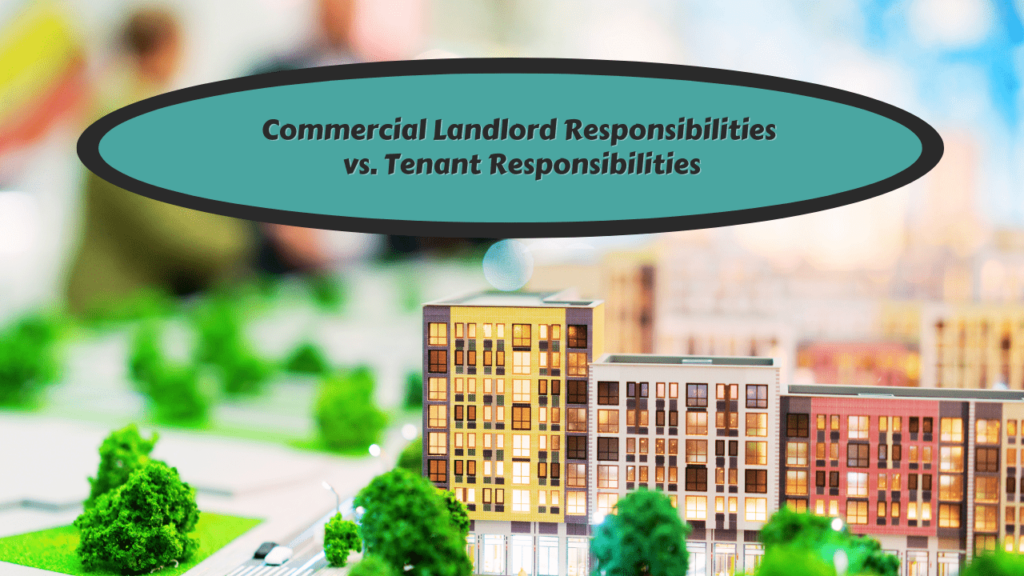
As a commercial property owner, what are your responsibilities versus your tenant responsibilities?
Unfortunately, there’s no easy answer.
The division of duties depends on a number of things, including the type of property you’re renting out, the tenants you’re renting to, and the conditions that are spelled out in your lease agreement.
Before you sign a lease and move in your commercial tenants, make sure all parties are on the same page when it comes to who is doing what. Some of the responsibilities will be obvious. Renting out a commercial office building, it’s unreasonable to think that your tenants will be responsible for plowing the parking area during a snowstorm or mowing the lawn surrounding your office complex.
Other things are less obvious, however. For example, who should pay for maintenance? Is there any reason that you should be required to make modifications to suit the needs of a specific tenant who is moving in?
What about security?
Typically, the responsibilities will actually depend upon the lease agreement.
Let’s talk about different lease types and what they mean for defining landlord responsibilities versus tenant responsibilities in a commercial rental space. This should help you identify what kind of lease agreement will work best for your own commercial property.
Dividing Responsibilities With a Full Service Gross Lease
With a full service gross lease in place, the tenant will basically be responsible for rent, and the property owner will be responsible for everything else, including all operating expenses. You can have this type of lease and charge tenants for their utility usage, but typically the responsibilities will fall to you. Expect to cover any building expenses, maintenance, insurance, and property taxes.
The tenants will ultimately be responsible for paying the rent, possibly the utilities, and complying with the requirements of your lease agreement.
With a Full Service Gross lease (often called a Full Service lease), you will be responsible for all operating expenses, such as critical maintenance, and potentially some upgrades and updates as they are needed throughout the tenancy. If paint begins to chip and fade, you’ll have to hire the painters and pay for the project. When the parking garage needs to be inspected, that’s your responsibility as well.
Managing the work is your responsibility. The expenses can be paid for either by the tenant or the landlord, based on what both parties have negotiated in the lease agreement.
A lease of this type will usually deliver a higher rental rate for you, but you’ll need to be prepared for all those expenses that come with owning and operating a property. Tenants who want to be as hands-off as possible will try to negotiate this type of lease so they only have one bill to pay on a monthly basis.
There are always exceptions, of course. You can write a full service gross release to limit what the owner pays in an annual period, leaving the tenant to be responsible for any additional expenses once that threshold is met.
If you want to keep most of the responsibilities on your own plate, this is the best sort of lease agreement for you.
Net Lease Agreements and Sharing Costs With Commercial Properties
A net lease will generally divide the financial responsibilities between tenants and owners.
Usually, the tenant will have to pay a portion of the building’s operating expenses. This includes common area maintenance, property taxes, and insurance. For example, if there’s a lobby with a receptionist or a security guard that asks people to sign in, all of the tenants in the building may contribute to the cost of that worker. When that same lobby has a fountain, maintaining it will be the responsibility of the tenants in the building who enjoy that fountain.
Your net lease will have its own specific responsibilities listed, depending on what you want to handle yourself and what you want your tenants to be responsible for. If you’re renting out a building with several commercial tenants, you might calculate each tenant’s pro-rata share of operating expenses based on square footage.
This is a reliable type of lease if you want your tenants to take on a larger share of the financial responsibilities involved in commercial properties. In the examples we listed, you as the owner would still be responsible for hiring personnel or negotiating vendor contracts to have a fountain cleaned. The cost would not be your burden, however.
Triple Net Lease Agreements
Often, the Triple Net lease is what commercial owners are really after. This is the lease agreement that puts most of the responsibility on the tenants and less responsibility on the owner. If you want to be as hands-off as possible, this is the lease for you.
With a triple net lease, the tenants agree to pay for rent, utilities, and all the operating expenses associated with your commercial property. The tenant is responsible for:
- Maintenance fees
- Building insurance
- Property taxes
When you have a triple net lease in place, you are not responsible for all those extra costs, but you can expect to earn less rent in exchange for the tenant taking on the extra fees and costs. You’re likely to negotiate a longer lease term and you may need to agree to lower rental increases once the initial lease term is complete.
This type of lease agreement leaves you, as the owner, liable for almost nothing. Even structural repairs that are needed at the building will be your tenant’s responsibility.
You will likely find that this type of lease agreement and division of responsibilities works best when you’re renting out a property to a single tenant. This would not work well with an office building that has dozens of tenants. It would, however, work very well for a shop owner in a free-standing, detached store, or a tenant who runs an industrial business out of a warehouse.
When you sign a Triple Net lease with your tenants, always be specific about the division of repair costs, otherwise you’re asking for conflicts and even lawsuits. Your tenant may try to negotiate a cap on how much they’ll pay to maintain your building during the course of their lease agreement. There may be additional inspections required before, during, and after the tenancy. Renewals will require a lot of negotiating.
You also have to decide how to approach the potential situation where a tenant fails to make the necessary repairs that are needed while bound to a Triple Net lease. How can you protect the condition of your property if your tenant is not making the necessary repairs to keep that property safe and valuable? You might end up dealing with deferred maintenance and other problems at the end of the lease term. To avoid that possibility, always include a detailed maintenance and repair agreement in the lease.
Modified Gross Lease
A modified gross lease puts you between the gross lease and the triple net lease, and responsibilities are almost evenly divided between landlords and tenants. To keep things simple, you can expect that a modified gross lease means that the tenant pays base rent, utilities, and a portion of operating costs.
Every modified gross lease will look a little different, and you and your tenants will have to decide how yours looks. Sometimes, tenants agree to pay only rent and utilities for the first year but then contribute to operating expenses and additional costs in larger increments each additional year of the lease term.
There is a lot of room for creativity and negotiation when you’re working with a modified gross lease. Depending on your tenant and your property, you can divide up who is paying for landscaping and security and upgrades and preventative maintenance as well as other operating costs.
Balancing Cost and Accountability
 As you decide what type of lease you want to set up, think about how you’ll balance your own accountability with that of your tenants. Do you want them to have the responsibility of maintaining your building? It can seem like a cost-saver, but it also means a lower monthly rent and no guarantee that they’ll maintain your property to the standards that you may set for yourself or for them.
As you decide what type of lease you want to set up, think about how you’ll balance your own accountability with that of your tenants. Do you want them to have the responsibility of maintaining your building? It can seem like a cost-saver, but it also means a lower monthly rent and no guarantee that they’ll maintain your property to the standards that you may set for yourself or for them.
The way you structure your lease and divide up the responsibilities will depend on you, your tenants, and the type of building you’re renting out. What works for an office building might be very different from what works best for a retail setting or an industrial warehouse.
Consult with a reputable commercial property management company like ours for the best advice. We have helped commercial owners decide how to handle lease agreements, maintenance, building adjustments, parking, elevators, and everything else that comes with renting out commercial property.
We’d love to have the opportunity to discuss this topic with you further. You can leverage our experience and resources for the best commercial results. Please contact us at Stripe Management. We work with owners, investors, and both residential and commercial properties in Prince George’s County, Montgomery County, Washington, D.C., and anywhere in the DC metro area.
